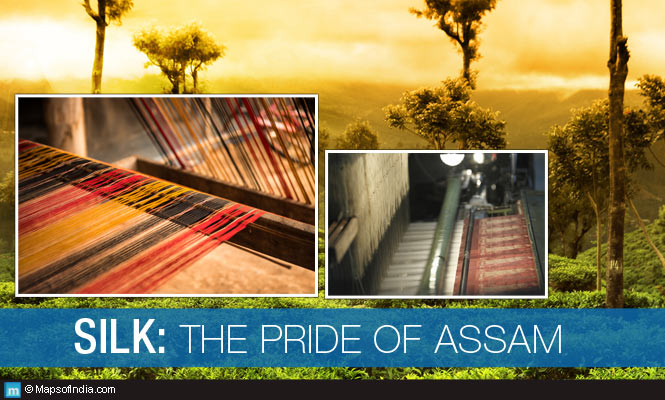
Weaving is one of the most important aspects of the cultural life of Assam. Weaving looms are found in almost every home in the villages of Assam. Silk products are very popular among foreign as well as domestic tourists visiting the state. The state produces three different varieties of silks. Each has its distinctive characteristics, which makes it unique from other silks. Those who have seen Assamese silk have always proclaimed that there is nothing like the “pat” or the “muga” or the “Eri” in Assam.
The Three Timeless Silks
Muga Silk is the pride of Assam and is a nature’s gift to the state. It is the only state in the country which produces Muga silk by rearing “Antheraea assamensis” or Muga worm (in Assamese language it is muga polu). This variety of Muga worm has the same lifecycle as a silkworm and is native to Assam. The golden colour and shine of Muga silk gives it a unique look. In fact, it is also known as the “muga” colour. Another unique characteristic of this type of silk is that the shine of the fabric improves after every wash. That is why, Muga silk is considered one of the costliest silks in the world and for every Assamese women, a Muga mekhala chaddar (traditional dress of Assamese women) or a muga saree is always a very prized possession, much like her gold ornaments.
In 2007, this variety of silk was given the Geographical Indication (GI) tag, valid for 10 years. This is basically an indirect way of patenting the product in the name of Patent Information Centre, Assam Science Technology and Environment Council (ASTEC). The fabric is today used in the production of not only the traditional but also modern dresses like tops, skirts, shirts, kurtis, including shawls and home furnishings products. It is said that Muga silk worm is as old a habitat as the dinosaur and the silk is supposed to be the strongest silk in the world, after the spider silk.
Pat Silk fabric in Assam is derived from silk worms that live on mulberry trees and is also known as Mulberry Silk or “Nuni pat” in Assamese. This type of silk has a distinctive white and off-white colour and is known for its brightness, high quality and durability. Way back in 1946, when Mahatma Gandhi visited Sualkuchi, the textile centre of Assam, Rajen Deka, a well-known designer of his time, gifted Gandhiji a portrait of him, weaved on a pat silk fabric. Gandhiji was so mesmerised by the quality and design, that he predicted that the weavers would weave dreams in their cloth. Pat silk is produced in limited quantities compared to the other two varieties of silk because very few mulberry worms are reared in Assam and usually sourced from other states.
Eri and Muga silk, which are produced in substantial quantity and are indigenous to the state, are extremely popular in Assam. This silk is derived from eri worm or Samia cynthia ricini, which is found in and around Assam and some parts of Japan and China. Eri silk fabric, also known as Endi, has a course and thick texture as most of the fabric is hand spun and is used for making shawls, jackets etc. However, nowadays, finer textures are also available, which are used for making sarees, summer stoles, kurtis etc. Eri silk is not only a warm and soft fabric, but also has excellent characteristics such as it is anti-fungal, non-toxic, bio-degradable and a most sustainable textile.
Sualkuchi Silk Industry
Sualkuchi, a village in the Kamrup district, is the only region in Assam which is exclusively into silk weaving and hence referred to as the “Manchester of Assam”. According to the Department of Industries and Commerce, Assam, has presently about 7,00,000 looms, but powered looms are of limited quantities and are mainly found in Sualkuchi. These are used for commercial production of silk fabrics. In fact, the hand-loom industry of Sualkuchi deals with three varieties of textiles commercially: cotton, silk and Khadi cloth.
Assam Silk: Losing its Glory
As a matter of fact, the popularity of Assam silk is gradually diminishing and is now not as popular as it used to be. The silks in Assam are mainly limited to making traditional dresses, though slight diversifications can be seen nowadays. There is still a lot to be done by the entrepreneurs and policy makers. The easy availability of other varieties of artificial silks from other areas and at cheaper costs have overshadowed these natural silks. It is to be noted that Assam silks are sustainable textiles and have a negative impact on the environment. If used in a proper manner, they can be a powerful growth propeller for the rural region. It is high time that effective measures should be taken by the government, traders and entrepreneurs to make Assam silk a larger global brand. Otherwise, the state will lose its status and dignity of being an indigenous silk producer of the country.



